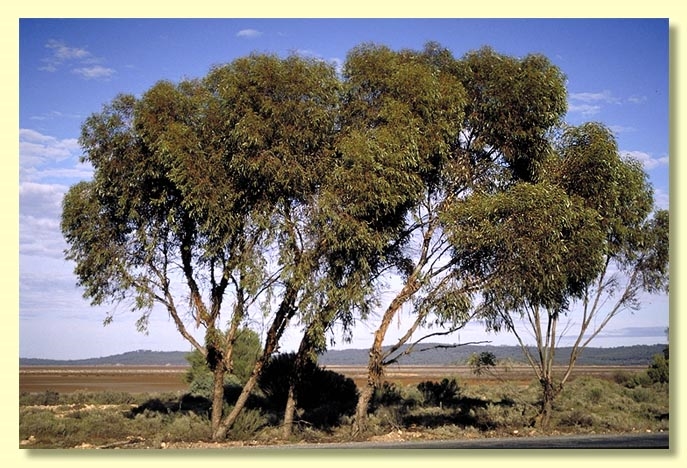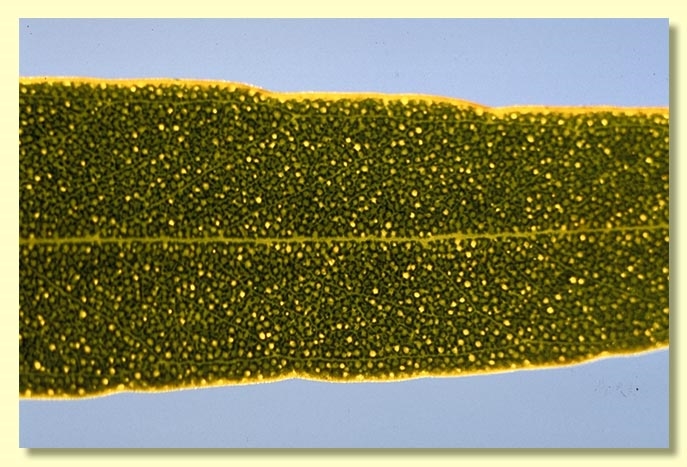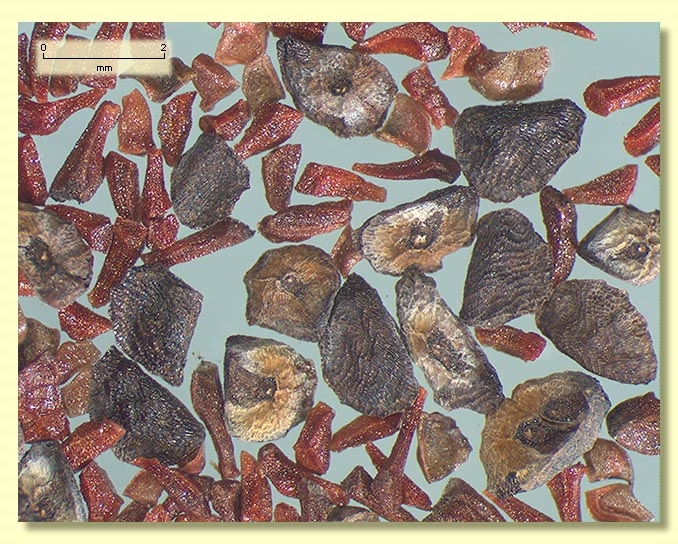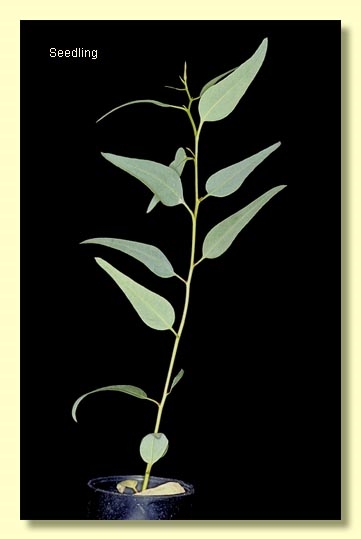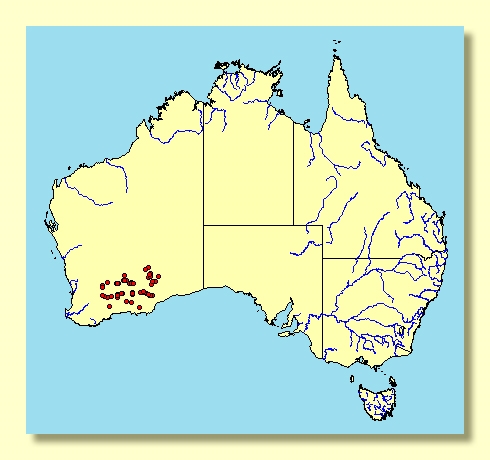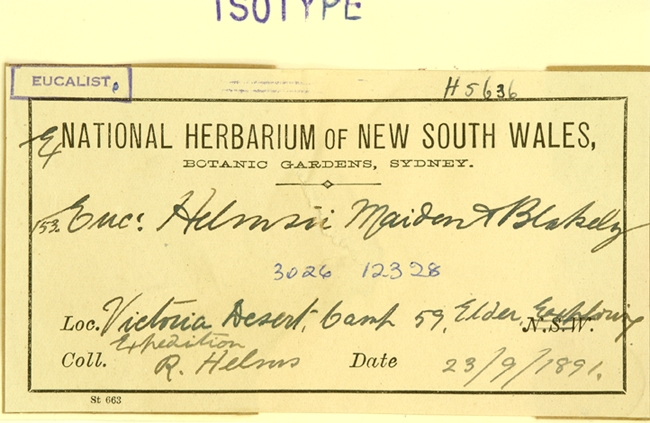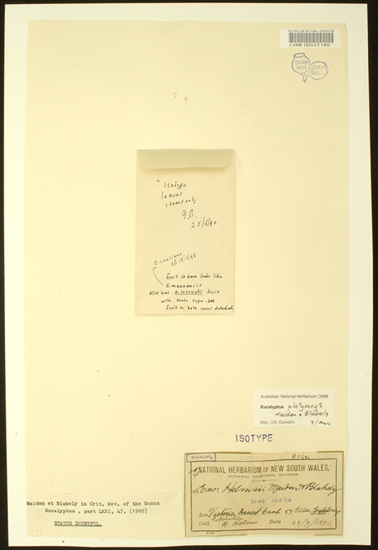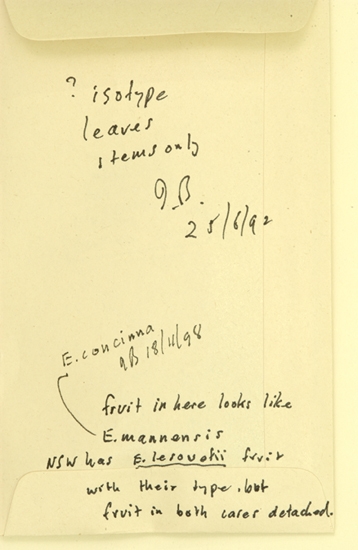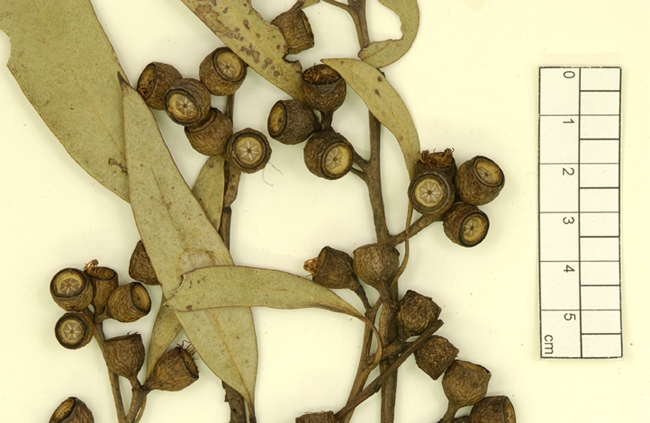Euclid - Online edition
Eucalyptus platycorys
Eucalyptus | Symphyomyrtus | Dumaria | Furfuraceae
T: Boorabin, W.A., 16 Jan. 1906, A.Morrison s.n.; holo: NSW; iso: K, PERTH.
Eucalyptus helmsii Maiden & Blakely, Crit. Revis. Eucalyptus 8: 47 (1929). T: near Camp 59, Victoria Desert, W.A., 23 Sept. 1891, R.Helms 14; holo: NSW; iso: AD, CANB.
Bark rough, dark grey, persistent fibrous and flaky for 0.3–1.5 m of trunks, rarely to base of larger limbs, stripping in ribbons above, smooth bark grey to whitish over coppery to yellowish.
Branchlets have oil glands in the pith.
Juvenile growth (coppice or field seedlings to 50 cm): stems rounded in cross-section; juvenile leaves shortly petiolate, alternate, lanceolate, 6–10 cm long, 1.5–4 cm wide, dull blue-green or slightly glaucous, becoming glossy green on sapling.
Adult leaves alternate, thick, petioles 1–3 cm long; blade lanceolate, (5)7–14 cm long, 0.8–2.3 cm wide, base tapering to petiole, margin entire, apex pointed, concolorous, glossy, green, side-veins greater than 45° to midrib, reticulation very dense, intramarginal vein more or less close to margin, oil glands mostly intersectional. Lenticels may be present on margin.
Inflorescence axillary unbranched, peduncles 0.3–1.5 cm long, buds 3(7), pedicellate, sometimes shortly so, pedicels 0.1–0.6 cm long. Mature buds usually cylindrical (0.8–1.7 cm long, 0.6–1 cm wide), bright red when mature, scar present (outer opercumum shed early), operculum rounded to conical or coarsely umbonate (0.3–0.8 cm long), striate or almost smooth, slightly wider than the hypanthium at the join, stamens inflexed, anthers cuboid, versatile, dorsifixed, dehiscing by longitudinal slits, style long and straight, stigma more or less rounded, locules 4 or 5, the placentae each with 4 vertical rows of ovules. Flowers creamy white.
Fruit normally pedicellate, rarely sessile, pedicels (0)0.2–0.5 cm long, cupular to cylindrical with conspicuous vertical operculum scar, smooth or scarcely ribbed longitudinally, 0.8–1.1 cm long, 0.8–1.1 cm wide, disc descending vertically, valves 4 or 5, enclosed or near rim level.
Seeds black to brown with paler scurfy patch on ventral side variable in size and centred on hilum, rarely extending to dorsal surface, 1.8–3.2 mm long, flattened-ovoid, dorsal surface shallowly reticulate, narrow partial flange often present but not conspicuously encircling the seed, hilum ventral.
Cultivated seedlings (measured at ca node 10): cotyledons reniform; stems square in cross-section; leaves always petiolate, opposite for 3 or 4 nodes then alternate, lanceolate, 6.5–9.5 cm long, 2–3 cm wide, green, dull to slightly glossy.
Flowering has been recorded in February, May, August, September and October.
A mallee endemic to Western Australia, from Boorabin to Newdegate in the south-eastern wheatbelt east to Fraser Range and the western part of the Great Victoria Desert (north of Kitchener). It occurs on sandy soils. The bark is rough on the trunks, branchlets always have pith glands and the adult leaves are glossy green and buds usually in 3s.
Eucalyptus platycorys belongs in Eucalyptus subgenus Symphyomyrtus section Dumaria because the buds have two opercula, stamens are strongly inflexed, ovules are in four rows on the placentae and cotyledons are reniform. Within this subgroup E. platycorys is closely related to only two other species—E. scyphocalyx and E. leptocalyx—forming series Furfuraceae. All three species have flattened grey-brown seeds that have a pale scurfy patch of variable size on the ventral side and have branchlets with oil glands in the pith.
The rough-barked, more inland-dwelling E. platycorys has cylindrical to pyriform buds in umbels of 3(7), whereas its coastal and sub-coastal relatives, E. scyphocalyx and E. leptocalyx, have (7)9 to 13 or even 15 buds per umbel. The cupular fruit of E. platycorys has a prominent wide vertical scar on the rim left by shedding of the inner operculum at flowering time. Mature buds of E. platycorys are usually bright red.
Eucalyptus platycorys has been confused with E. incrassata because of bud number, adult leaf features and fruit shape which may indeed be very similar. E. incrassata belongs in a different series (series Incrassatae) and can always be distinguished by the conspicuously flanged and ribbed seeds, whereas the seeds of E. platycorys are more flattened, ribless, slightly scurfy and the flange, if present, is inconspicuous. Further E. incrassata frequently has few or no pith glands.
The recently published E. scyphocalyx subsp. triadica (see K.D. Hill et al, 2001) is here regarded as part of E. platycorys and is included in synonymy. The type specimen is from the southern part of the range of E. platycorys and has immature fruit which may account for their being slightly smaller than is usual.

